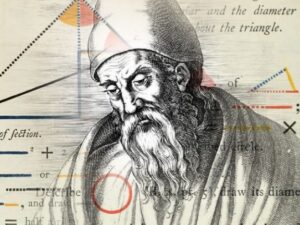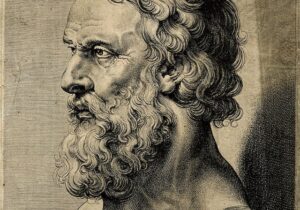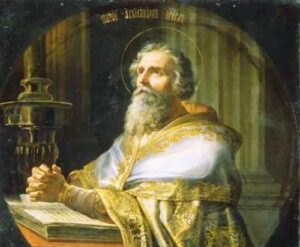One of the chief aims of mathematics has always been to reveal and describe an order in the natural world. Mathematics, as a language, reveals this order and harmony, yet it should also be lifted from this concrete foundation and brought into the world of the abstract.
 A resurgence of interest in classical education has been evident in recent years. This has been due, in part, to a number of influential writings on regaining “lost” knowledge in our culture which have, in turn, inspired an increasing number of schools founded on a classical model. When surveying the landscape of classical education, it becomes evident that there is a clear vision available for the purpose of the study of humanities. What does not seem as clear, though, is the nature of mathematics in a classical education.
A resurgence of interest in classical education has been evident in recent years. This has been due, in part, to a number of influential writings on regaining “lost” knowledge in our culture which have, in turn, inspired an increasing number of schools founded on a classical model. When surveying the landscape of classical education, it becomes evident that there is a clear vision available for the purpose of the study of humanities. What does not seem as clear, though, is the nature of mathematics in a classical education.
How is mathematics to be approached? Is mathematics a science? Is it a set of skills to be memorized? Can the study of mathematics be more deeply integrated into a classical education? If so, is this necessary or desirable? Nearly everyone would agree that the study of mathematics belongs in a classical education, but the purpose of this study is not always clear.
Mathematics can be looked at from many different directions. I quote Morris Kline from his book Mathematics for Liberal Arts:
Perhaps we can see more easily why one should study mathematics if we take a moment to consider what mathematics is. Unfortunately the answer cannot be given in a single sentence or a single chapter. The subject has many facets or, some might say, is Hydra-headed. One can look at mathematics as a language, as a particular kind of logical structure, as a body of knowledge about number and space, as a series of methods for deriving conclusions, as the essence of our knowledge of the physical world, or merely as an amusing intellectual activity.
Mathematics is any one of these or some combination, depending on the context. The purpose of this essay is to address how mathematics should be viewed to obtain a clearer picture of the ultimate aim of its study in a classical education. This discussion will primarily involve upper mathematics, or the mathematics typically seen in the eighth through twelfth grades. In a future article, I plan to discuss elementary mathematics in a classical education.
What is the purpose of the study of mathematics in a classical education? As one classical school states it:
The study of mathematics should instill in students an ever-increasing sense of wonder and awe at the profound way in which the world displays order, pattern, and relation. Mathematics is studied not because it is first useful and then beautiful, but because it reveals the beautiful order inherent in the cosmos. (from “The Education Plan of St. Jerome Classical School,” Hyattsville, MD)
Johannes Kepler, seventeenth century German physicist best known for his work on planetary motion, said something very similar four hundred years ago:
The chief aim of all investigations of the external world should be to discover the rational order and harmony which has been imposed on it by God and which He revealed to us in the language of mathematics… Just as the eye was made to see color and the ear to hear sounds, so the human mind was made to understand quantity.
One of the chief aims of mathematics has always been to reveal and describe an order in the natural world.
If we look back to the early days of mathematics, say four thousand to five thousand years ago, we will see what the Egyptian and Babylonian civilizations offered in mathematics. They offered a very practical approach to mathematics answering questions that rarely extended beyond what was necessary to operate in daily life. During this time, rudimentary arithmetic and algebra were built up to answer questions in commerce and agriculture. The useful purposes for which they employed mathematics dealt with: monetary exchange, simple and compound interest, computing wages, expressing weights and lengths, dividing inheritances, and determining volumes of granaries and areas of fields. Their mathematics was also used to study astronomy, making it possible to create calendars to accurately predict natural occurrences such as floods, something necessary for agricultural purposes. Accurate calendars could also be used for purposes of religious ceremony, such as building temples so that the sun would shine on the altar at the appropriate time. These civilizations developed an elementary arithmetic, notation, some early algebra, and basic empirical formulas in geometry.
When considering classical mathematics, the Greeks must be a main focus of our attention. In fact, the primary reason for discussing earlier mathematics is to understand what the Greeks inherited and what they left to their posterity.
Whereas the Egyptians and Babylonians produced a fairly crude and very practical mathematics based on experience, the Greeks removed mathematics from its practical underpinnings. A major step in the advancement of mathematics was the recognition that mathematics – in numbers and geometric figures – can be dealt with in the abstract. This was not a small step in human thinking, and this initial step has been attributed to the Pythagorean School of ancient Greece.

Euclid
Set up in the abstract, reasoning can now take over to form the basis of mathematical thought. One of the greatest gifts given to us by the Greeks is this gift of improved reasoning and this reasoning was brought into, honed, and perfected in mathematics. Mathematical results became a chain of propositions, arising out of preliminary assumptions, and advanced by reasoning. Probably the best illustration of this is Euclid’s Elements, a set of thirteen volumes covering geometry of the plane and space as well as many results in number theory.
In approximately 300 B.C., Euclid brought together much of what was known in mathematics up to that point and organized it in such a way that, beginning with short list of abstract statements assumed to be true and armed with reasoning, he pieced this body of knowledge together as an extended chain. He did so in such a way that the Elements became the standard textbook in geometry for the next twenty-two hundred years. It is only in recent years – approximately the last one hundred years – that the Elements has been discarded as required reading for all educated people.
With the strengthening of the connection between mathematics and reasoning by the Greeks, mathematics would next become closely tied to philosophy, theology, and the natural sciences. Consider the following from Plato’s Republic (Book VII):
The knowledge at which geometry aims is knowledge of the eternal, and not of anything perishing and transient. Geometry will draw the soul towards truth, and create the spirit of philosophy, and raise up that which is now unhappily allowed to fall down. Therefore, nothing should be more sternly laid down than that the inhabitants of your fair city should by all means learn geometry.

Plato
Also from the Republic (Book VII) concerning the formation of leaders:
We must endeavor that those who are to be the principal men of our State to go and learn arithmetic, not as amateurs, but they must carry on the study until they see the nature of numbers with the mind only; … arithmetic has a very great and elevating effect, compelling the soul to reason about abstract number, and rebelling against the introduction of visible and tangible objects into the argument.
The abstraction that Greeks brought to mathematics should never be discounted in importance. I take this extended quote from Mathematics for Liberal Arts by Morris Kline:
The abstractions of mathematics possessed a special importance for the Greeks. The philosophers pointed out that, to pass from a knowledge of the world of matter to the world of ideas, man must train his mind to grasp the ideas. These highest realities blind the person who is not prepared to contemplate them. He is, to use Plato’s famous simile, like one who lives continuously in the deep shadows of a cave and is suddenly brought out into the sunlight. The study of mathematics helps make the transition from darkness to light. Mathematics is in fact ideally suited to prepare the mind for higher forms of thought because on one hand it pertains to the world of visible things and on the other hand it deals with abstract concepts. Hence through the study of mathematics man learns to pass from concrete figures to abstract forms; moreover, this study purifies the mind by drawing it away from the contemplation of the sensible and perishable and leading it to the eternal ideas.

Proclus
That mathematics was considered central to a classical education can also be seen through the Quadrivium. The Quadrivium consists of four mathematically-based subjects first laid out by the Greeks and forms the basis of the continuing medieval liberal arts education after the study of the Trivium. The Quadrivium consists of arithmetic, music, geometry, and astronomy which were described by Proclus in the following way:
Arithmetic as the study of quantity
Music (harmonics) as the relationship between quantities
Geometry as the study of magnitudes at rest
Astronomy as the study of magnitudes in motion
While it can be argued that mathematics as its own subject began with the Greeks, it certainly did not end there. After the Greek contributions, there was very little advancement in mathematics until the fifteenth century. In fact, until that time much of Greek mathematics had been lost to the Western world and it was during the Renaissance that much of it began to be recovered.

Rene Descartes
In the sixteenth and seventeenth century, figures such as Rene Descartes and Pierre de Fermat, pushed further by the desire to discover order in the universe, brought geometry out of abstraction and pure reasoning by introducing a new setting, what is known today as the Cartesian coordinate system. Coordinate systems allowed more readily for measurements of natural events in the universe and paved the way for such greats as Newton and Leibniz who further developed these ideas in Calculus.
It was this period that helped usher in the “mathematization” of science, an ever-increasing attempt to discover order in the physical universe through the language of mathematics. This led to a tremendous growth in knowledge in both mathematics and science, but these advancements have come at a cost.
In modern times, mathematics is often seen as a language useful primarily to scientists. The honing of reasoning skills – a critical component of a liberal education – is often downplayed or completely neglected in mathematics education. The cohesive structure of mathematics is often discarded to more quickly get to the “useful” results, but then these “useful” results are often useless because this language of mathematics is without its cohesive structure and, therefore, the order of the universe remains unclear.
With the repeated emphasis on usefulness, it may be that modern mathematics education is much closer in the spirit to the Egyptians than the Greeks.
To give an overview of the basis of a classical upper mathematics curriculum, the curriculum should be interested in the structure of mathematical concepts in the abstract, and provide the opportunity to begin to see how these concepts provide insight into how we see the world around us. Above all, being faithful to Greek ideals, the mathematics curriculum should provide the opportunity for students to better grasp the abstract nature of mathematics, to hone reasoning skills, and to see the order inherent in mathematics.
In terms of content, students would explore not just Greek mathematics, but also mathematics as it progressed in the seventeenth and eighteenth centuries, very briefly.

Ancient Greek Mathematics
Algebra I allows us to take our knowledge of elementary arithmetic, further organize it, and place it into the setting of Descartes.
Geometry allows us to hone our reasoning by developing its propositions systematically starting from an initial set of postulates. Using reasoning, the body of knowledge is built up in a manner similar to how it was so expertly organized by Euclid and his contemporaries.
Algebra II and trigonometry allow us to place our understanding of geometry in an analytical framework in the spirit of Descartes, developing the field of analytic geometry which, in turn, is used to develop a description of motion and other questions of order in the universe.
I should add that the classical curriculum should include discussions of the original settings which led to the development of mathematical concepts. These could include projective geometry, which arose as a tool for artists in depicting the real world and proceeded to provide innovation in mapmaking. The mathematical concepts which followed from the study of sound led to an increased understanding of light and electrical current. The plethora of calculators in modern times has meant a change in the use of logarithms, but it is still incredibly worthwhile for students to understand how and why they were originally created. Bringing this context into the classroom allows students to see the interrelatedness of various ideas in mathematics and science and better understand the creativity involved in the discovery of these concepts.
Of course, this curriculum could potentially include a study of calculus. If students have been properly prepared, then calculus may very well be an appropriate step. I would warn you, though, against following the current trend in education of making it a goal to push as many students as possible through calculus during high school for its own sake. This is often done for prestige sake, since calculus is seen as difficult and useful in many fields. From experience, this practice often leaves large gaps in the students’ education.
Let me also offer the warning that finding and adopting appropriate textbooks and supplements for upper mathematics can be a difficult task. I believe most readily available materials end up leaving a decision between the least of the evils. Appropriate materials are available, but they take time and effort to put together.
The mathematics curriculum in a classical education will seek to promote the understanding of order and harmony in the universe. Mathematics, as a language, reveals this order and harmony, yet it should also be lifted from this concrete foundation and brought into the world of the abstract. The study of mathematics will engage this endeavor by training students in the context in which the discovery of its concepts arose as well as the reasoning which provides its structure. Although the study of mathematics has fallen well short of this purpose in modern times, its implementation will deepen a classical education.
Seventeenth century philosopher and mathematician René Descartes made the following observation concerning the mathematics of his own day.
I afterwards bethought myself how it could be that the earliest pioneers of Philosophy in bygone ages refused to admit to the study of wisdom anyone who was not versed in Mathematics…. I was confirmed in my suspicion that they had a knowledge of a species of Mathematics very different from that which passes current in our time.
Nearly three hundred and fifty years ago, Descartes lamented a lost knowledge in mathematics. He understood that the mathematics passed down from his predecessors was only a shadow of what it had formerly been. That observation is as fitting today as it was in the time of Descartes.
The above essay was first published in August 2012 and was adapted from a lecture given at Hillsdale College on June 25, 2012 during the seminar “What Makes Classical Education Different?”
Written by Thomas Treloar for The Imaginative Conservative – January 23, 2023

 FAIR USE NOTICE:
FAIR USE NOTICE: